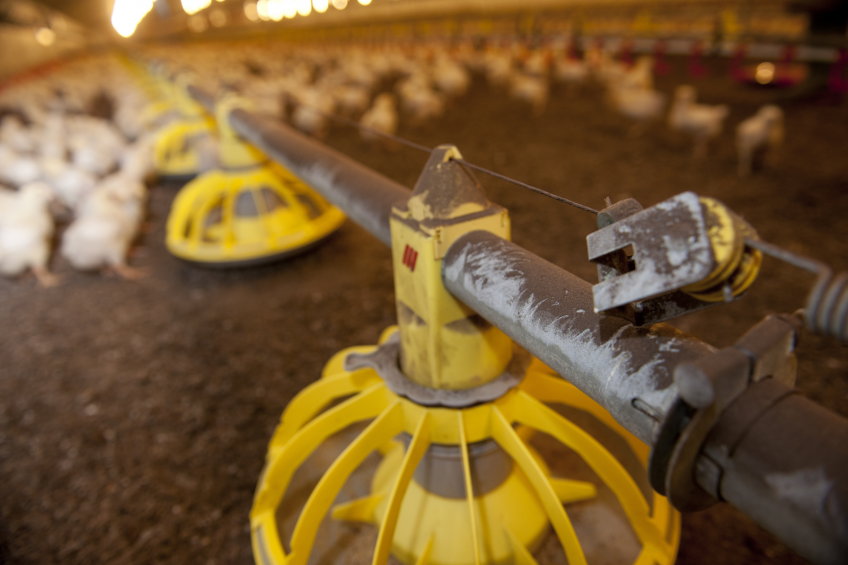Endotoxins and their negative impact on poultry

Endotoxins, present everywhere in a broiler’s environment, pose a genuine threat that can impair the immune system and performance. A multi-strategy toxin risk management solution can counteract both endotoxins and mycotoxins.
Endotoxins, are part of the outer membrane of the cell wall of all Gram-negative bacteria (E. coli, Salmonella, Shigella, Pseudomonas) that are released from the bacterial cell wall by shedding or through bacterial lysis. These toxins called also lipopolysaccharides (LPS) because of their structure, consisting of a lipid and a polysaccharide (Figure 1). While there are many natural sources of endotoxins, for example, air, dust, food, water, and faeces, the major source is the gastrointestinal tract.
Figure 1
Endotoxin contamination – why we should care
Poultry are exposed to lipopolysaccharides throughout their lives. In healthy birds, the intestinal and other epitheliums such as skin or lungs, represent an effective barrier that prevents the passage of lipopolysaccharides into the bloodstream. Once there, however, endotoxins can elicit strong immune responses, weakening birds’ immune systems and impairing performance. Severely pronounced immune response can lead to septic shock.
Recent research shows that exposure to lipopolysaccharides through dust in the environment impairs the immune response in chickens and can lower resistance against pathogenic insults. For these reasons, greater care regarding endotoxin exposure is crucial for proper animal health and performance.
Flock exposure
In recent years, new concerns have emerged about nutritional, environmental, and social factors that may disrupt the barrier function and/or increase exposure to lipopolysaccharides. Such exposure may result in clinical or sub-clinical signs that ultimately affect poultry production. Septic shock is very often related to infection by pathogenic Gram-negative bacteria that produce lipopolysaccharides. However, the presence of lipopolysaccharides in blood can also be due to metabolic or gut barrier problems along with issues related to the intestinal microflora. Given that many of the factors vary from bird to bird, a combination of factors as a whole will result in disparate impacts within a flock.
Dietary changes
Dietary changes play a clear role. For example, moving birds from a corn-based diet to a rye-wheat-barley diet was shown to increase lipopolysaccharide levels in blood serum along with inflammatory markers. Other factors can significantly contribute to endotoxin-associated problems. For instance, in summer high temperatures inside poultry units can induce heat stress. In other livestock species, it is well established that a 1-20°C increase in inner body temperature causes the intestinal tight junction proteins to be affected, thereby increasing intestinal permeability and allowing more lipopolysaccharides to enter the blood stream. Whether the same mechanism applies to poultry is currently under investigation.
Sub therapeutic use of antibiotics in some countries not only raises concerns about antibiotic resistance but also about the change in gut microflora and the plausible release of lipopolysaccharides in the gut lumen that results from killing Gram-negative bacteria. In addition, mycotoxins such as deoxynivalenol are also very well known to disrupt the intestinal barrier. The multitude of factors relating to lipopolysaccharide exposure helps explain the disparate impact on birds.
Reducing LPS in birds
A trial was conducted with the aim to investigate the influence of a multi-component mycotoxin deactivator (Mycofix® Select, MSE) on performance and health status of broiler chickens fed diets naturally contaminated with mycotoxins in an environment with high pathogen pressure from E. coli.
Over 600,000 day-old broiler chickens (Ross or Hubbard) were investigated in this field study. The animals were allocated on three different farms. On each farm two houses were compared at the same time (control vs group fed MSE). In each production cycle the birds were kept until 35 days of age. The feed contained a mixture of mycotoxins consisting of B-trichothecenes such as deoxynivalenol (200 ppb), fumonisins (470 ppb) and zearalenone (75 ppb).
Figure 2
Besides performance parameters, intestinal content samples were taken for surveying the endotoxin load. Figure 2 displays the results for the endotoxin concentration in stomach content of broilers at the end of the trial. The addition of a multi-component mycotoxin deactivator proved to be effective, counteracting low level of mycotoxin challenges in combination with E. coli pressure.
Overall performance of broiler chickens was enhanced; the endotoxin load in the gut lowered and the negative effect of E. coli was reduced. These results reinforce the importance of counteracting the effects of endotoxins in order to protect birds’ health and improve performance.













